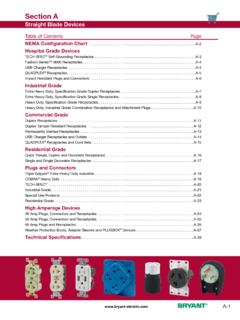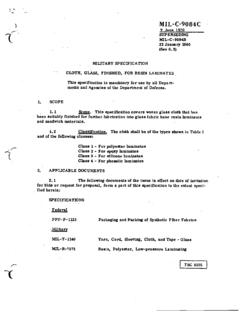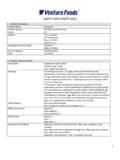Transcription of BioBased 1701s - mtmcg
1 DescriptionBioBased 1701s is a water blown, two-part, closed cell, bio-based spray applied, poly-urethane foam having a nominal density of ( kg/m3).When spray applied, BioBased 1701s expands 30:1, filling voids, crevices and building cavities, and can reduce energy consumption needed for climate control by reducing infiltration. Once installed, BioBased 1701s assists in increasing ther-mal resistance, and can assist in reducing the risk of moisture accumulation within the building Installation BioBased 1701s must be installed by certi-fied dealers who have successfully completed a BioBased Insulation approved training program or BioBased Insulation approved field certification training which covers proper application techniques, environmen-tal health and safety, building science and building code standards.
2 Always consult with local building code in-spectors prior to installing BioBased 1701s . Evaluation CriteriaFor proper use of this material, refer to the BioBased Insulation Certified Dealer Train-ing Manual and the following building codes and guides:2009 International Building Code (IBC) Chapter 262009 International Residential Code (IRC) Section R314 API publication Ax-230: Fire & Safety Guidelines for Use of Rigid Polyurethane and Polyisocyanu-rate Foam Insulation in Building Architectural ReferenceDivision: 07 Thermal and Moisture Protection Section: 07210 Building Insulation Model architectural specifications in CSI three-part format are available upon Recommended UsesBioBased 1701s can be used in residential, commercial and industrial applications. The following design assemblies are a general design guide only.
3 BioBased 1701s may be useful in other applications. Always consult with the local authority having jurisdiction before use. General: BioBased 1701s must be separated from the occupants by ( ) thick gypsum wallboard or an equivalent 15-minute thermal barrier complying with, and installed in accordance with, IBC Section or IRC Section as applicable, except when installed in attics and crawlspaces. The maximum thickness of the insulation is 7 ( mm) in the walls and ( mm) in the Application with a Non-Prescriptive Thermal Barrier:In areas above 8 in height and where the foam plastic insulation will not be damaged, punctured, or torn, Flame Seal TB may be used to cover BioBased 1701s in lieu of the prescribed 15-minute thermal barrier. The foam plastic insulation thickness must not exceed 8 (203 mm) in walls and 8 (203 mm) in ceilings, and the insulation must be covered with dry mils (25 wet mils) of Flame Seal TB intumescent.
4 The insula-tion must be dry, clean and free of dirt and loose debris or other substances that could interfere with the adhesion of the coat-ing. The foam plastic insulation must not be shaved, with the original skin intact. Flame Seal TB may be applied by airless sprayer at ambient temperatures between 50 F and 115 F (100 C and 46 C) and rela-tive humidity of less than 70 Application with a Non-Prescriptive Ignition Barrier: BioBased 1701s may be installed in attics and crawlspaces in accordance with section through with a non-prescriptive ignition barrier on the interior side of the insulation provided that all of the following conditions are met:Entry to the attic or crawlspace is only for the service of open combustion appliances are permit- ted in the attic or air is provided in accordance with IMC Section are no interconnected basement or attic of the attic or crawlspace is provided in accordance with the applicable code, except when BioBased 1701s is installed in unvented attics in accordance with Section of the IRC.
5 Technical Data SheetBioBased 1701s Copyright BioBased Insulation Revised 1-05-2010 BioBased Insulation 1475 W. Cato Springs Rd., Fayetteville, AR 72701 | vertical surfaces must be covered with a minimum nominal thickness of dry mils (11 wet mils) of Foam Kote 50-50a intumes- cent coating OR dry mils (12 wet mils) of Flame Seal Conditioned Attics: BioBased 1701s may be spray applied to the underside of the roof deck and rafters. BioBased 1701s is applied at a maximum thickness of (140 mm) on horizontal and/or diagonal surfaces and a maximum of (114 mm) on vertical surfaces. The attic floor/ceiling must not be insulated. No vapor retarders are installed on the attic exhaust ventilation ducts extend to the exterior of the Vented Attics (use on attic floors): BioBased 1701s may be installed at a maximum thickness of (140 mm) between joists in attic floors/ceilings.
6 The attic must be separated from the interior of the building by an approved 15-minute thermal Conditioned Crawlspaces: BioBased 1701s may be installed in crawl-space walls provided that all of the following conditions are met:One of the following methods of ventilation is provided:Continuously operated mechanical exhaust ventilation at a rate equal to 1 cfm ( L/s) for each 50 ft ( m2) of crawlspace floor area, including an air pathway to the com- mon area (such as a duct or transfer grille).Conditioned air supply sized to deliver at a rate equal to 1 cfm ( L/s) for each 50 ft ( m2) of crawlspace floor area, including a return air pathway to the common insulation is applied at a maximum thick- ness of (114 mm) on exposed earth is covered with a continu- ous vapor barrier.
7 Joints of the vapor barrier shall be overlapped by a minimum of 6 (152 mm) and be taped or sealed. The edges of the vapor barrier shall extend up the stem wall a minimum of 6 (152 mm). The insulation is not installed within 6 (152 mm) of the insulation fills and seals the rim/band joist insulation is applied to the crawlspace ceiling. Vented Crawlspaces: BioBased 1701s may be installed in crawlspace ceilings and coated with Flame Control Foam Kote 50-50a ignition barrier provided that all of the following conditions are met:Ventilation openings are located in the foun- dation walls with a net free opening area of not less than 1 ft ( m ) per 150 ft (14 m ) of under-floor ventilation opening is provided within 3 ( m) of each insulation is applied in direct contact with the underside of the sub floor at a maximum thickness of (254 mm).
8 No insulation is applied to the crawlspace Kote 50-50a is applied to the surface of the foam insulation at a minimum nominal thickness of 12 wet mils. Application Below Grade: BioBased 1701s may be installed on the exterior of foundation walls. For applica-tion guidance follow SPFA AY-140 "Spray Polyurethane Foam for Exterior Subgrade Thermal and Moisture Protection" and local building code. Safety and Handling Refer to Material Safety Data Sheet (MSDS). prior to application of BioBased 1701s . Storage temperatures for both A and B components should be between 60 F ( C) and 90 F ( C) out of direct sunlight. Conditioned trailers or storage areas may be necessary. Use adequate ventilation to keep airborne particulates below the exposure level. Wear respiratory protection if material is heated, sprayed, or if the exposure limit is exceeded.
9 Empty drums should be dry, punctured with a non-sparking tool and sent to a qualified drum recycler. Liquid product should be incinerated in a licensed facility in accordance with local, state and federal regulations. Do not discharge to waterways or sewer systems or dispose of on the case of Chemical Emergencies: Call CHEMTREC (800) 424-9300 or (Collect) (703) 527-3887 (USA) Application Guidelines*While prepping equipment, heating drums and re-circulating for spray foam applica-tion, agitate the B component mildly for 15 to 30 minutes before application using a pneumatic or equivalent performing mixer. Agitate for approximately 1 to 2 hours for a maximum of 4 hours each day during ap-plication to prevent per pass should be between ( ) and 1 (38 mm). Thin passes, [ ] or less, should be avoided and may result in reduced yield.
10 Exceeding an overall depth of 4 (102 mm) in 24 hours can cause internal charring of the foam and spontaneous combustion. Do not exceed 4 (102 mm) in 24 hours at any depth per a 5 to 10 second time interval be-tween passes to allow foam to cure and reduce the likelihood of blowing the uncured foam away from the substrate.*It is important that applicators review and un-derstand the BioBased Insulation Certified Dealer Training Manual prior to use or application of BioBased 1701s . Failure to follow the manu-facturer s recommended guidelines may cause the warranty to become null and void. BioBased 1701s Technical Data Sheet page 2 of 3 Copyright BioBased Insulation Revised 1-05-2010 BioBased Insulation 1475 W. Cato Springs Rd., Fayetteville, AR 72701 | Flushing/Purging Chemical blown foams followed by BioBased 1701s water blown foam:When using BioBased 1701s after a chemi-cally blown spray polyurethane foam it is necessary to flush the entire system with a non-water based solvent in order to achieve maximum foam quality and Water blown foams followed by BioBased 1701s .



